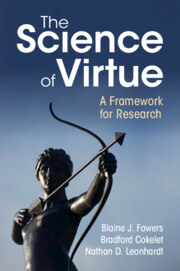Book contents
- The Science of Virtue
- The Science of Virtue
- Copyright page
- Contents
- Acknowledgments
- Introduction
- Part I Philosophical Resources and Prospects
- Part II Psychological Resources and Prospects
- Part III Organizing Virtue Research with the STRIVE-4 Model
- Part IV The Science and Practice of Virtue
- References
- Index
Introduction
Why Study Moral Virtue?
Published online by Cambridge University Press: 11 January 2024
- The Science of Virtue
- The Science of Virtue
- Copyright page
- Contents
- Acknowledgments
- Introduction
- Part I Philosophical Resources and Prospects
- Part II Psychological Resources and Prospects
- Part III Organizing Virtue Research with the STRIVE-4 Model
- Part IV The Science and Practice of Virtue
- References
- Index
Summary
The introduction asks the question of why social scientists should study virtues empirically. It offers five reasons: (1) humans are moral animals, (2) moral behavior can be understood as an expression of acquired traits, (3) it is psychologically realistic to think that ordinary humans can acquire and express virtue traits, (4) moral education is valuable, and (5) virtues are often taken to be essential to a good life. The Introduction then addresses three challenges that virtue scientists must face: (1) the absence of empirically oriented virtue theory, (2) the overreliance of simple survey design in psychology, and (3) virtue skeptics. The Introduction concludes with an outline of the chapters of the book and how these chapters comprise the sections of the book.
Information
- Type
- Chapter
- Information
- The Science of VirtueA Framework for Research, pp. 1 - 22Publisher: Cambridge University PressPrint publication year: 2024
